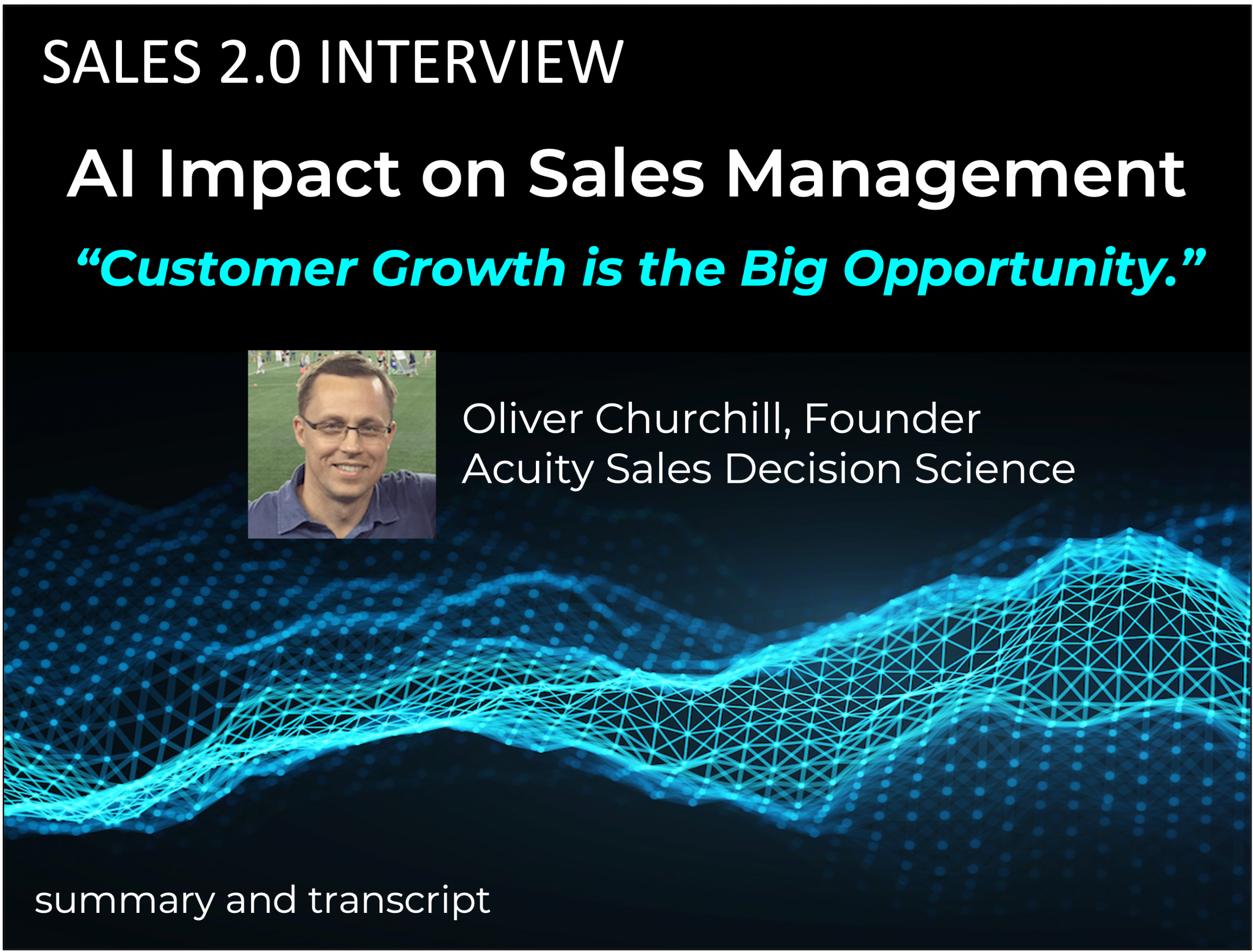What’s the Future of AI in Sales Management?
This is the first in a series of interviews with sales management subject matter experts, examining the current and future states of AI in sales.
This first interview is with Oliver Churchill, the founder and CEO of Acuity Sales Decision Science. Acuity enables B2B sales teams “to improve sales productivity in implementing prospecting and customer growth strategies using flexible process technology and Artificial Intelligence (AI).”
Oliver knows the space and has been a sales management practitioner for 20+ years. I was curious to hear what he thinks.
A summary of our conversation is below, followed by the full interview transcript.
1. Right now, we’re creating small improvements with AI
According to Oliver, applications such as ChatGPT, search topic intent data and conversation intelligence create small improvements to the way we sell by taking advantage of readily available data. However – “Longer term, there will be novel AI applications to solve hard problems that create order of magnitude value. But the data doesn’t exist yet. So those problems are not yet available to AI.”
2. We need New Data, and to create it, we need New Processes
To solve “hard problems”, such as ensuring “Right Things, Right Times, Right Reasons” we are going to need new data and to get that requires new processes. Oliver gave the example of Waze in GPS. Waze “changed the game from shortest distance to shortest time”. They did this by having users download their app and drive around in traffic – serve as sensors on the traffic network. New traffic pattern data enabled model training to reduce time-to-destination. We’re going to see applications more like this in the B2B sales world in the future… where time-to-destination (sales stage conversion) is also the goal.
3. AI will help with hyper-personalization
Taking a “Do More with Automation” approach to prospecting is producing diminishing returns because buyers are worn out by email spam and robo-calling. AI will help us with hyper-personalization so that we can provide more valuable, relevant content.
4. The big AI opportunity is existing customers
Oliver says, “Mature companies generate at least 90% of their revenues by taking care of customers and incrementally growing them and finding opportunities in different divisions… down the hall and around the corner.” He says there’s a lot of potential in applying AI to maximizing revenue from existing customers through an ongoing, multi-stage relationship lifecycle, whereas many of today’s sales tools focus on high-in-funnel initial conversations for a single sales stage conversion.
5. We are just getting started with AI in sales
Despite the airwaves being filled with talk of ChatGPT and its applications to sales and marketing, Oliver’s perspective is that “…the AI road is long and there is a tremendous amount of value… think trillions of dollars over the coming decades… in AI-driven sales productivity increases to be realized.”
Interview Transcript
Nigel: Where do you see, or how do you see AI impacting the sales profession in the next couple of years?
Oliver: In the short term, AI innovation is likely to be more of the same, namely opportunistic, where opportunities pop up to add value because… they are a thing you can do now with AI that you couldn’t do before. Call that… “Just add AI.”
For example, with ChatGPT, there is a lot of written text to mine. It’s there, you can do it. Very cool, and now new applications of that capability are popping up. You can also record conversations, turn them into text, and do sentiment-based text mining… Conversation Intelligence. And then there are various flavors of “mining the Internet”. You can mine the Web for contact info (like Zoominfo) and intent signals. Existing data being analyzed to find Insights is a good use case, and it adds value.
However, these are incremental capabilities where the path to value exists today, due to convenient data availability.
Longer term, there will be novel AI applications to solve hard problems that really create Order of Magnitude Value. But the data doesn’t exist yet.
As such, solutions to many problems are not yet available to AI.
Nigel: If the data doesn’t exist, how will it be created?
Oliver: New processes have to be created. For example, if you want to improve the efficiency of how people create new sales pipeline, close deals, retain and cross-sell customers… where’s the data for that?
CRM lacks process management, and therefore process… sales behavior pattern… data is unavailable. It’s low quality to the point of not being worth analyzing.
Today, “Sales Analytics” mostly means charting results, but that doesn’t provide insight into what behaviors created those results. It’s doing new and better things to improve results where the value is… currently trapped.
Nigel: With the kind of work you are doing in your company, would you say you are creating new sales processes – so they can be analyzed and improved?
Oliver: Yes. We’re creating new processes, flexible, human-in-the-loop processes – to drive growth. And once they exist, they can be explored and improved using data science… as-a-service.
So far, in the process automation space, the big players in RPA [Robotic Process Automation] – they’re basically removing people from processes by automating them away. But I think major value will come from AI-enhanced human behaviors.
An analogy for this, which people throw around a lot but don’t go into the Why… and why Google spent $1Billion on an acquisition…is Waze.
Waze changed the GPS game from Shortest Distance to Shortest Time by implementing a new, closed-loop, data-science-driven process to optimize… reduce… travel time. They took on and beat Google. How?
Google Maps had location and distance data. They could ensure that you got to your destination and didn’t get lost… and using posted speed limits, estimate how long it would take.
Waze had a different goal… to Save Time… not caring as much about location services and not being lost, which was table stakes. But no relevant data existed about traffic patterns.
So they created it. Drivers download the Waze app onto their phones and drove around. “Hey kids… go play in traffic!” Phones collected… in essence… sensor data.
Once they got that data, which is constantly being refreshed, it could be analyzed to create Insights, and then their mobile app closed the loop from Insight (“This is the fastest way to get there…”) to Value Creation via Process Change (“Here are your turn-by-turn directions to save 17 minutes getting to the airport at rush hour…”).
Waze is a novel application of analytics, with a closed Insight to Action loop that directly captures value by saving time.
It’s important to note… that Analytics are only 10% of the solution… and only relevant to crunch data once it exists. Predicting how long the drive will be wasn’t the goal. The goal was to save time, actually, so they provide real-time, adaptive guidance… and they measure how long your drive takes in reality, to further train their models. It’s not a one-time analysis to get an prediction on what “might” happen. It’s a living, breathing smart system that delivers real value … by saving time… as it is used.
In the sales world, knowing that the forecast is light, or that the conversation sentiment was positive or negative, or that buyer Intent was… what it was… is useful, but not the goal. These are just the Insights portions. They are a diagnosis with no cure.
More value would come from knowing what to do to improve the forecast… what to do to build enough pipeline and sell more to close the gap. This requires a behavioral process change… new, intelligent guidance… or Next Best Action recommendations.
Longer term, more solutions will combine complex system dynamics with insights and actions to realize business value directly.
Nigel: People often talk about… “Our best-performing salespeople… Do This.” Is that a starting point for this kind of thing?
Oliver: If there is data that describes it, then yes. But if it’s offline… not captured as data… or in my head because I’m a 30-year sales rep and I have special sauce, and by the way, I buy everyone holiday gifts and play golf with them… That’s not in the system. It’s a one-off and can’t be analyzed. There are best practices and human insights for sure – which are very valuable – but that’s not fertile ground for scalable AI.
Going back to the Waze example… a critical mass of real time data flows through their platform. In the sales world, emails, calls… increasingly texts… content usage and engagement, conversation dynamics and frequency… plus things like renewal dates, product usage patterns… they are all becoming available through CRM, Marketing Automation, ERP and data warehouses… converging… and therefore available more and more for AI-driven analysis and real-time guidance to optimize salesperson time.
Nigel: It seems like sales leader commentary and industry research are saying the number of times you need to reach out or try to reach out to someone is just going up and up. How do you think it’s going to play out?
Oliver: I think it will keep playing out… the way it is now. So, if I mail-merge-spam a thousand people, maybe I’ll get some responses, more than if I sent to 100 people. But the next time there will be diminishing returns because people are worn out by spam. The counterpoint to that, personalization, is happening, some of it good, and some of it not.
Nigel: When you say personalization, what do you mean… and envision?
Oliver: Something that communicates that the salesperson… is a real person… Like there’s no way that some mail merge program could’ve known that about me. Or that we have a friend in common and that friend introduced us, or you worked in my industry and you read my 10K report and you have a unique perspective on how to add value to the business… because you demonstrate that you know how it works. Or there is a live exchange of value via a live conversation. Those still matter!
Convenient “Just add AI” applications have seasoned people to thinking that AI value comes from removing people from processes. I think the opposite. I think AI adds more value when it plugs people… with limited time… into processes at the Right Time for the Right Reasons… to maximize high-value, personal interactions.
Nigel: Do you think that personalization is going to become easier with AI systems?
Oliver: Yes, by all means. It’s already easier to be more hyper-personal and we’ll probably see more things that are really successful and some that are not. Like any new thing.
Nigel: Given that we might be in a minor recession, a lot of people are talking about selling to existing clients. What do you see here?
Oliver: Studies show it’s 5x – 10x more efficient to extend and grow an existing customer relationship than to create a new one. Plus… mature companies generate at least 90% of their revenues by taking care of customers and incrementally growing them and finding opportunities in different divisions… down the hall and around the corner. It has always been the best way to grow revenues…to take care of your precious customers.
Nigel: Is this going to be an area where AI is going to play a big role?
Oliver: Yes. Economics… eventually… drives the focus of tools and technologies on where value can be attained. So far, a lot of sales tech has focused on early-in-the-funnel activities, on starting conversations with prospects.
But companies really care about their existing customers, and ongoing conversations… that hopefully never end… so customer service and existing customer engagement are the most sensible places for technology to be applied. That’s where all the dollars come from.
This is where we are seeing a lot of demand.
Nigel: That’s why you definitely have to show you’re human.
Oliver: You have to be… really human… as in, yourself, not a bot-like replacement for a person, to manage an ongoing dialogue with another person… your customer… through a multi-stage lifecycle.
A lot of companies we’ve seen in the last two years have ten thousand to… hundreds of thousands of customers… where, on average, the most recent conversation with them is more than five years ago, or unknown. What?! They become a new customer and they’ve been using your product or service, but no one has talked to them… and there is a good chance that your primary contact left the company. It’s everywhere.
So how to improve that process? You can’t use AI yet; there’s no process to improve.
The key is… doing things in the first place… like regularly connecting with customers… and collecting the data about those interactdions because you want to solve a hard problem. Having the process comes first. And then once you have that going, it’s eligible for optimization using AI.
Nigel: If you were a sales leader, are there tools you would definitely remove from your tech stack?
Oliver: It depends on priorities, which vary widely.
At an early stage company, the total addressable market is unclear, so market research tools, social signals, along with prospecting tools and auto dialers all make sense. You have to stir the pot with a lot of energy… get people in the door.
But later on, those tools aren’t as relevant. Tools for customer care and success and upsell/cross-sell/retention become more important. And I think some of those tools are still being invented. It’s ripe for novel AI applications.
Nigel: If you were running a sales team, what would be the top two things you would look at to see if you were well placed to hit your goal this year?
Oliver: For me, it’s 1-2 punch… of having a detailed go-to-market strategy paired with an execution capability… people and processes in place that you actually run and track and manage to realize the market opportunity.
Last year we surveyed more than 500 Director- and VP-level sales leaders and asked them if their sales teams are “Doing the right things at the right times for the right reasons?”
There were 3 answers:
- 70% Not sure/Don’t know
- 25% No (sometimes a salty “Hell no!”)
- 5% Yes
This is a big opportunity for sales leaders… going one or two levels deeper from the training between sales kickoffs… to get into the nuts and bolts of “How do Fred and Martha actually execute their territory coverage plans in a way that makes sense…and that’s easy for them?”
In many companies, salespeople have freedom… also known as being cut adrift… to figure it out on their own… without the difficult operational implementation details of “When, how and why should I engage this customer and, is there content for that and are there case studies for this?” Defining and assembling those things adds value because it saves reps from having to reinvent the wheel, and most importantly… guess how to allocate their limited selling time. Standard methods also create process consistency, which unlocks the path to analysis and improvement.
Nigel: What’s your take on the phrase “tech bloat” where teams feel they have too much technology, and it’s overwhelming?
Oliver: Tech has sprung up where incremental solutions are easy to build. “This can be done… so why not?” But those low hanging fruit solutions don’t solve the GTM strategy to execution problem in a smart, comprehensive way and I think that’s the bloat that people feel: “I’ve got all this tech but I still have the same problems I had yesterday.”
Sales management is still offline, and processes are inconsistent, even invisible. Until these problems… opportunities really… are addressed, AI will be a cool thing in patches and “Future View” tech industry articles, but not solve the “Right Things, Right Time, Right Reasons” question in a modern way.
The reality is – we’re just getting started.
The AI road is long and there is a tremendous amount of value… think trillions of dollars over the coming decades… in AI-driven sales productivity increases to be realized.



 © 2020 Acuity Sales Decision Science
© 2020 Acuity Sales Decision Science
